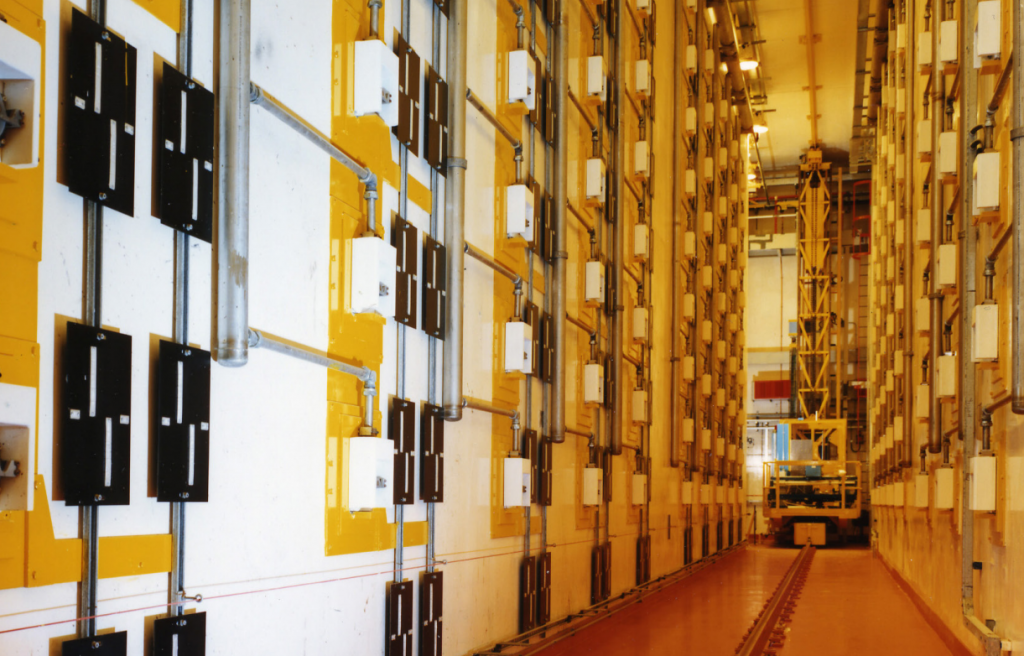Britain has 139 tons of plutonium. That’s a real problem.
By Christopher Fichtlscherer, Friederike Frieß, Moritz Kütt | April 17, 2020
 Plutonium storage at the Sellafield nuclear site. Photo credit: Nuclear Decommissioning Authority, 2019.
Plutonium storage at the Sellafield nuclear site. Photo credit: Nuclear Decommissioning Authority, 2019.
The United Kingdom’s last plutonium reprocessing plant, B205, located in Sellafield in northern England, will shut down by the end of 2020. It will bring an end to the era of plutonium separation in the country, which began 68 years ago. Because the United Kingdom never used any of the material it recouped from reprocessing except in nuclear weapons, today it has amassed a stockpile of almost 139 metric tons of separated plutonium.
This creates lasting problems: Plutonium stored in Sellafield is highly toxic and poses a permanent risk of proliferation. It is enough material to build tens of thousands of nuclear weapons. According to parliamentary estimates, storage will cost the British government about 73 million pounds a year for the next century. But after decades of public and private consultation, there is still no accepted plan for its disposition. In the meantime, the Nuclear Decommissioning Authority is working on the consolidation of the stockpiles in Sellafield and developing the capability to retreat the packages to allow for long-term storage once the government makes a final decision on permanent disposal. The United Kingdom views the material as a resource and is pursuing options that involve burning the plutonium in reactors, even though multiple assessments have shown risks associated with such a choice, namely immature concepts and technology. A better alternative would be to treat it as waste and begin planning for its permanent immobilization and burial.
Where did it come from? In the beginning, the British plutonium separation program was justified by military needs. A few years later, nuclear euphoria led to an increasing number of civil nuclear power plants and to dreams of nuclear-powered cars and planes. It was predicted that uranium resources would not be able to fulfill the need. As a result, the idea of a “closed” fuel cycle was born: instead of using nuclear fuel once and throwing it away, the spent fuel is reprocessed and reused in (mostly fast) reactors. In theory, this would allow greater utilization of uranium. However, the concept has never been demonstrated on an industrial scale, and only a few countries still aim at closing the nuclear fuel cycle.
From 1956 until 2015 the United Kingdom operated 26 Magnox reactors for commercial use. Magnox reactors are fueled with natural uranium, moderated by graphite, cooled by carbon dioxide gas, and designed in a way for efficient plutonium production. A pilot reprocessing plant, B204, started operation in 1952 and was replaced in 1964 by the B205 reprocessing plant. Combined, the two plants have separated more than 85 metric tons of plutonium from spent fuel.
In 1976, the United Kingdom started operating a new reactor class, the Advanced Gas-cooled Reactor, and 15 such reactors still operate today. To reprocess spent fuel from these reactors as well as spent fuel from overseas, the United Kingdom opened the Thermal Oxide Reprocessing Plant in 1995. Its operation record is a disaster: It never reached planned throughputs, had a serious leakage of radioactive material in 2005, and was much more expensive than originally intended. Consequently, it was shut down in 2018 before reaching the end of its planned service life—and after separating only 23 metric tons of plutonium.
But what happened to the fast breeder reactors that were supposed to burn up reprocessed fuel and close the nuclear fuel cycle? There are several reasons why there are only two fast reactors commercially operating, the Russian-designed BN-600 and BN-800. First, nuclear energy did not expand as foreseen in the 1950s and 1960s, while at the same time new uranium resources were discovered, easing worries about a dwindling uranium supply. Second, multi-cycled use of spent fuel has proven to be far more difficult than expected, and there are some risks inherent only to fast reactors. Finally, there is the latent proliferation risk of the technology to separate plutonium and uranium from the spent fuel.
Where will it go? Today, the United Kingdom’s civilian stockpile contains 139 metric tons of plutonium, including 23 metric tons owned by other countries, mostly Japan. The Nuclear Decommissioning Authority has discussed two disposition options. First is the reuse of plutonium in reactors. Reuse is touted as a proliferation-resistant option because the spent fuel would be too radioactive to handle, at least at first. Second is immobilization. Here, the plutonium is mixed with other materials that reduce the risk of leaching and complicate extraction. Potentially, the radioactive waste in the mix could also serve as a toxic obstacle to proliferation. Both options would still ultimately require disposal in a deep geological repository.
The Nuclear Decommissioning Authority’s preferred option still seems to be the reuse of the plutonium in mixed-oxide fuel for light water reactors. However, such an option depends on the availability and willingness of reactor operators to use such fuel. And not all operators are keen on the idea: EDF, the French-owned utility company that operates Hinkley Point C, the first nuclear power plant built in Britain in decades, denied the suggestion to consider the use of mixed-oxide fuel in 2013.
Alternatively, the plutonium might be used in reactors that, according to their vendors, are better suited to cope with the plutonium stockpile. These could be either a CANDU-EC6 heavy water reactor or the small, fast, sodium-cooled reactor concept PRISM. Using mixed-oxide fuel in CANDU reactors seems viable, but the Nuclear Decommissioning Authority assesses no potential benefit compared to using the same fuel in a light water reactor—at greater implementation risk. In March 2019, the authority officially removed the PRISM reactor from the list of viable options, though even as early as 2011 it was stated internally that the “technology maturity for the fuel, reactor, and recycling plant are considered to be low.”
Nevertheless, the Nuclear Decommissioning Authority confirms that it will continue to monitor fast reactor programs.
Leaving aside the viability of fuel production, costs, and everything related to actual operation of the PRISM reactor, we conducted an analysis of GE Hitachi’s claims that PRISM “could conceivably make the entire UK plutonium stockpile proliferation-resistant in 20 years” by irradiation. Our calculations show that the claim is highly optimistic. Using plutonium as a reactor fuel has two effects: Some plutonium is burned, and the remaining is left in highly radioactive spent fuel. The radioactivity creates a barrier for malicious actors intending to steal and separate the plutonium from that fuel—providing proliferation resistance. However, due to radioactive decay, this barrier continuously decreases, while treatment of other parts of the stockpile is underway. Even though our study’s findings apply specifically to the PRISM reactor, we anticipate similar effects from other irradiation options. In the time it takes to treat the United Kingdom’s massive stockpile in reactors, the already treated material will slowly lose its proliferation resistance.
Why should the public sector continue to pay money for “new” reactor concepts—sometimes under development for decades—when it is not even clear whether these concepts might solve the problem at hand? The United Kingdom has to find a solution for its plutonium stockpile, and quickly. The British government, the Nuclear Decommissioning Authority, and reactor operators in general should accept that separated plutonium is a burden, not a resource, and authority should again take a closer look at immobilization options. These do not have the sheen of new, high-tech solutions like burning the plutonium in specially-tailored reactor concepts. But given that action is urgently needed, established and working concepts should be the way forward.
Together, we make the world safer.
The Bulletin elevates expert voices above the noise. But as an independent nonprofit organization, our operations depend on the support of readers like you. Help us continue to deliver quality journalism that holds leaders accountable. Your support of our work at any level is important. In return, we promise our coverage will be understandable, influential, vigilant, solution-oriented, and fair-minded. Together we can make a difference.
Keywords: PRISM, United Kingdom, fast reactors, plutonium separation, spent fuel reprocessing, spent fuel storage
Topics: Nuclear Risk, Opinion

















The authors are wrong about the history of most of this plutonium. The first generation Magnox reactors were designed for weapons production and electricity. The fuel was uranium metal with a magnesium alloy clad. Like other production reactor fuel, it was designed to be easy to reprocess; but it degrades in storage and is pyrophoric if ignited. It was first reprocessed for weapons and then reprocessed to convert the fuel form into a more stable high level waste glass and chemically stable plutonium oxide. The 205 reprocessing plant became a waste management operation where shutdown was determined by the shutdown… Read more »
Our cost estimates are based on cost estimates by the UK government. These are not negligible (73 million pounds per year). In fact, the government’s Nuclear Decommissioning Authority itself states: “Continued, indefinite, long-term storage leaves a burden of security risks and proliferation sensitivities for future generations to manage.” (https://www.gov.uk/government/publications/progress-on-plutonium-consolidation-storage-and-disposition). The same source furthermore states that safe and secure management is indeed a priority for the UK government. Regarding the history of the UK plutonium: Indeed, in the beginning reprocessing of MAGNOX fuel was foreseen as the default waste management solution, as spent MAGNOX fuel cannot be stored in water. However,… Read more »
Plutonium can be used to make radioisotope thermoelectric generators for deep space probes and various other spacecraft, for example the Curiosity rover on mars, or the Voyager probes.
Beyond the frost line solar panels become increasingly less feasible as an energy source. There is actually considered to be a world shortage of plutonium for this application. 139 tons doesn’t sound like an awful lot in the great scheme of things.
You’re talking about plutonium 238, which isn’t a factor here. Whatever tiny portion of this inventory might be 238, the other plutonium isotopes (not to mention all the other contaminants) makes it virtually irretrievable for use in space probes.
One would’ve thought that seeing both the US and USSR test nuclear weapons would’ve convinced the rest of the world never to manufacture the things. Too bad it turned out otherwise.
At least post-apartheid South Africa dismantled its nukes.
The authors of this piece act like Britain’s plutonium stockpile is sitting out in the parking lot waiting to be hauled off by ISIS. For starters, 139 tons of plutonium would fill about twice that many milk crates. All of it could be easily stored in one room, which could be underground at Britain’s most secure military base (if they were so worried about it). The scare-mongering that this is urgent and dangerous is simply unwarranted and irresponsible, but the authors are in the business of proliferation risk so the realities don’t make their specialty sufficiently necessary, I guess. The… Read more »
Our risk assessment of the current storage form is in part shared by the UK government. The government’s Nuclear Decommissioning Authority itself states: “Continued, indefinite, long-term storage leaves a burden of security risks and proliferation sensitivities for future generations to manage.” (https://www.gov.uk/government/publications/progress-on-plutonium-consolidation-storage-and-disposition). Storing plutonium is harder than storing milk crates! And while the reactor use of plutonium could in theory release, there are many reasons why this is not done in practice. Reactor concepts like PRISM have been around for decades, but have not been built. Reasons are manifold. Our findings show that such use would only have minor and… Read more »
This article also serves as a posterchild example of continued human stupidity….. Why? Plutonium storage will cost the British government 73 million pounds a year for the next hundred years. That’s 7.3 billion pounds. Do you how much money that is? Assuming it currently cost’s a British student approximately 36,000 pounds in tuition to receive a four year Oxford University education, 7.3 billion pounds would pay for a four year Oxford University education of nearly 203,000 British students. Oxford University had a record attendance of 12,152 in April 2018. Assuming that value, the amount of money used to store plutonium… Read more »
I think you put your “Why?” at the wrong place. It should be at the end of the next sentence: “Plutonium storage will cost the British government 73 million pounds a year for the next hundred years. Why?” As Charles Forsberg points out above, storage of this should be quite cheap, a point I tried to convey in my original post. Where is all that money going?
The problems with the proposed solution in this article are at least two-fold: (1) the UK does not have a repository (like everyone else) and hence there would be no disposal path for the “permanently immobilized” material and (2) “permanently immobilized” has only temporal meaning because it may be considered immobilized now, but one thing that can be said about radiochemists is that given time and resources they can separate anything. A positive that can be found by the UK program is that they have managed to place the vast majority of their plutonium at one site where the protection… Read more »
WIPP is the permanent repository that stores all of the US transuranic waste. It has been receiving shipments for more than 20 years.
A brief perspective on the strategic options open to the UK in managing its plutonium stockpile, and commentary on recent underpinning research and development, was published in September 2020:
https://www.nature.com/articles/s41529-020-00132-7
In summary, a final decision on the implementation of reuse or immobilisation options for the UK plutonium inventory is not immediately required. Both options will require decades to implement and need further research to reduce technological and commercial uncertainties. In the meantime, facilities and plans are in place, to safely and securely store the UK plutonium inventory, for the interim.